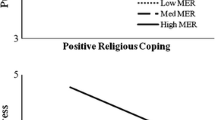Abstract
This study examined the association between strength of religious faith and coping with the terrorist attacks in New York City, Washington DC, and Pennsylvania on September 11, 2001, the resulting war in Afghanistan, and subsequent anthrax attacks. The participants included 97 students from a West Coast Catholic university. Measures included the Santa Clara Strength of Religious Faith Questionnaire, the Marlowe-Crowne Social Desirability Scale, the Symptom Check List-90-Revised, the Impact of Event Scale, a 10-point stress, coping, and importance of faith scale, and an author-developed questionnaire assessing demographic as well as qualitative questions regarding coping with terrorism. Results suggest that strength of religious faith was not associated with coping with terrorism.
Similar content being viewed by others
REFERENCES
American Psychological Association. (2001). Survey helps portray the substantial impact of terrorism. Practitioner Update, 9(2), 2.
Batson, C. D., & Ventis, W. L. (1982). The religious experience: A social-psychological perspective. New York: Oxford University Press.
Bazel, M., & Schwanhausser, M. (2001). Locals rush to buy goods, many customers stock up on food, others, gas masks. The San Jose Mercury News, p. A19.
Bernstein, E., Calhoun, D., Cegielksi, C., Latham, A., Shepherd, M.C., Sparks, K. J. et al. (1995). Perceived stress, religious coping styles, and depressive affect. Journal of Psychology and Christianity, 17, 33–34.
Bickel, C. O., Ciarrocchi, J. W., Sheers, N.J., Estadt, B. K., Powell, D. A., & Pargament, K. I. (1998). Perceived stress, religious coping styles, and depressive affect. Journal of Psychology and Christianity, 17, 33–42.
Blaine, B., & Croker, J. (1995). Religiousness, race, and psychological well-being: Exploring social psychological mediators. Personality and Social Psychology Bulletin, 21, 1031–1041.
Catipovic, V., Ilakovac, V., Durjancek, J., & Amidzc, V. (1995). Relationship of eight basic emotions with age, sex, education, satisfaction of life needs, and religion. Psychological Reports, 77, 115–121.
Cosar, B., Kocal, N., Arikan, Z., & Isik, E. (1997). Suicide attempts among Turkish psychiatric patients. Canadian Journal of Psychiatry, 42, 1072–1075.
Crowne, D. P., & Marlowe, D. (1960). A new scale of social desirability independent of psychopathology. Journal of Consulting Psychology, 24, 349–354.
Derogatis, L. R. (1977). SCL-90 Manual-I. Baltimore: Clinical Psychometric Research.
Ellison, C. G. (1991). Religious involvement and subjective well-being. Journal of Health and Social Behavior, 32, 80–99.
Gorsuch, R. L., & Venable, G. D. (1983). Development of an "age universal" I-E revised scale. Journal for the Scientific Study of Religion, 22, 181–187.
Holtz, T. (1998). Refugee trauma versus torture trauma: A retrospective controlled short study of Tibetan refugees. Journal of Nervous and Mental Diseases, 186, 24–34.
Horowitz, M., Wilner, N., & Alvarez, W. (1979). Impact of Event Scale: A measure of subjective stress. Psychosomatic Medicine, 41, 209–218.
Miller, M. (2001). Europeans show solidarity with the U.S., but fear their cities will become battlegrounds; Aftermath: While mourning victims, some are concerned about the form any American reaction may take. The Los Angeles Times, p. A13
Pergament, K. I., Kennell, J., Hathaway, W., Grevengoed, N., Newman, J., & Jones, W. (1988). Religion and the problem-solving process: Three styles of coping. Journal for the Scientific Study of Religion, 27, 90–104.
Plante, T. G., & Boccaccini, M. T. (1997). The Santa Clara Strength of Religious Faith Questionnaire. Pastoral Psychology, 45, 375–387.
Plante, T. G., Manuel, G. M. (1992). The Persian Gulf War: Civilian war-related stress and the influence of age, religious faith, and war attitudes. Journal of Clinical Psychology, 48, 178–182.
Plante, T. G., Manuel, G., Menendez, A., & Marcotte, D. (1995). Coping with stress among Salvadoran immigrants. Hispanic Journal of Behavioral Sciences, 17, 471–479.
Plante, T. G., Saucedo, B., & Rice, C. (2001). The association between religious faith and coping with daily stress. Pastoral Psychology, 49, 291–300.
Plante, T. G., & Sherman, A. C. (Eds.) (2001). Faith and healing: Perspectives on the relationship between religious faith and health outcomes. New York: Guilford.
Plante, T. G., Simicic, A., Anderson, E. N., & Manuel, G. (2002). Stress and coping among displaced Bosnian refugees: An exploratory study. International Journal of Stress Management, 9, 31–41.
Richards, P. & Bergin, A. (Eds.). (2000). Handbook of Psychotherapy and Religious Diversity. Washington, DC: American Psychological Association.
Ruby, C. L. (2002) The definition of terrorism. Analysis of Social Issues and Public Policy, 9–14.
Shooka, A., Al-Haddad, M., & Raees, A. (1998). OCD in Bahrain: A phenomenological profile. International Journal of Social Psychiatry, 44, 147–154.
Strahan, R., & Gerbasi, K. C. (1972). Short homogeneous version of the Marlowe-Crowne Social Desirability Scale. Journal of Psychology and Theology, 21, 235–238.
Thearle, M. J., Vance, J., Najman, J., Embelton G., & Foster, W. (1995). Church attendance, religious affiliation and parental responses to sudden infant death, neonatal death and stillbirth. Omega, 31, 51–58.
Trenholm, P., Trent, J., & Compton, W. C. (1998). Negative religious conflict as a predictor of panic disorder. Journal of Clinical Psychology, 54(1), 59–65.
Author information
Authors and Affiliations
Corresponding author
Rights and permissions
About this article
Cite this article
Plante, T.G., Canchola, E.L. The Association Between Strength of Religious Faith and Coping with American Terrorism Regarding the Events of September 11, 2001. Pastoral Psychology 52, 269–278 (2004). https://doi.org/10.1023/B:PASP.0000010027.00357.03
Issue Date:
DOI: https://doi.org/10.1023/B:PASP.0000010027.00357.03




